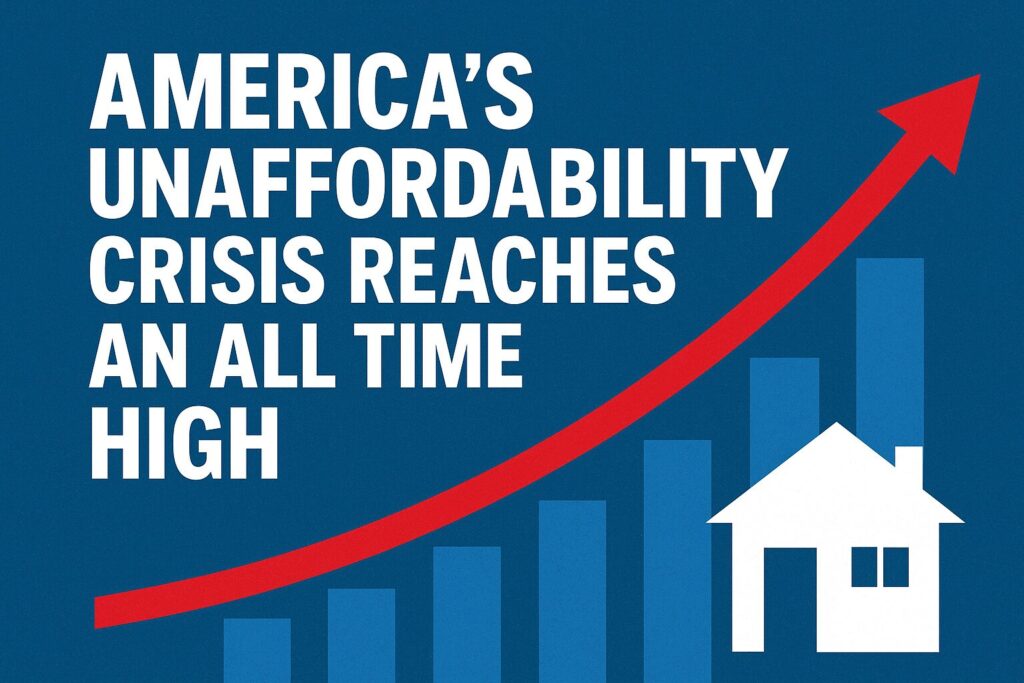Major Takeaways:
Rising housing costs and stagnant wages have created a nationwide affordability crisis impacting both renters and homeowners.
More than half of U.S. renters now spend over 30% of their income on housing, with many paying over 50%.
Without major reforms in housing supply, wage growth, and policy, millions of Americans will remain locked out of homeownership.
Unaffordability Crisis in America Reaches an All Time High
The cost of living in the United States has reached a tipping point, and the numbers say it: more Americans than ever are being squeezed by what it takes just to keep a roof over their heads and basic necessities within reach. This is no longer a problem isolated to one city or income group. It has become a national crisis affecting everyone from young professionals to retirees.
Housing remains the most visible pain point. Home prices compared to median household income have reached record highs, with the ratio now around five times higher on average. In some areas, it’s far worse. Millions of households can no longer afford to purchase even a modest home under standard lending guidelines.
Renters are struggling just as much. About half of all renters now spend more than 30 percent of their income on housing costs, and over a quarter are spending more than half of their paychecks just to keep a place to live. The pressure is not limited to low income workers either. Many middle class families and professionals are finding themselves priced out of neighborhoods they once considered affordable. In almost half of the nation’s metro areas, a six figure salary is now required to buy an average home.
The root causes of this affordability breakdown come from a combination of rising costs and slower income growth. Over the past several years, wages have increased by around 38 percent nationwide. But during that same time, rents have risen by about 50 percent, home prices have climbed 80 percent, and the costs of health care and child care have each risen around 40 percent. The gap between what people earn and what they must pay to live is widening fast.
The supply side of housing adds more fuel to the fire. There is a significant shortage of affordable homes across the country, which continues to push prices higher. Some analysts estimate that this shortage is costing the economy trillions of dollars in lost wages and productivity each year. Since 2020, home prices have jumped more than 50 percent in many markets, while median wages have only gone up by about half that amount. The imbalance has created home price to income ratios approaching levels never seen before.
The impact on everyday Americans is profound. A record number of renters are now considered cost burdened, meaning they spend more than 30 percent of their income on rent. Homeowners are not faring much better. Property taxes have risen sharply, and insurance premiums have climbed even faster. For first time buyers, entering the housing market has become nearly impossible. The income needed to afford a typical home has risen well above $120,000 a year, pricing out a large portion of the population.
This growing affordability crisis forces tough choices. Many renters are moving farther away from work to find cheaper housing, adding transportation costs and time to their daily lives. Others are delaying marriage, children, or retirement savings to make ends meet. Families are taking on extra jobs, moving in with relatives, or living with roommates well into adulthood. The traditional pathway to homeownership and financial stability is slipping out of reach.
The American dream has always been rooted in the idea that hard work leads to a home, a secure life, and a stable future. But that dream is under serious pressure. Rising costs, limited housing supply, and stagnant wages are reshaping what it means to live comfortably in America. For many, survival has replaced prosperity as the new standard.
Looking ahead, the road to restoring affordability will require bold changes. Increasing housing supply is essential to cool off prices. Wage growth must keep pace with living costs to restore balance. Local and federal policy reform may play a major role in reducing the strain, from zoning updates to incentives for affordable construction and targeted support for working families. Without decisive action, the number of people locked out of stable housing will continue to climb.
The affordability crisis is not just about economics. It affects where people live, how communities grow, and whether the next generation can build wealth or even hope for stability. The issue reaches deep into the core of the American experience. While the situation is grim, the potential for change still exists — if we face the problem head on, with a focus on solutions rather than politics.














